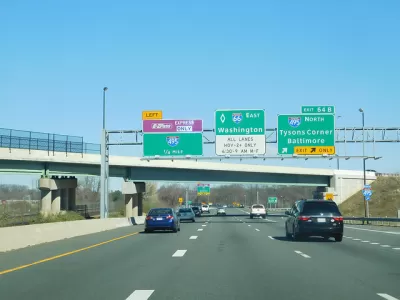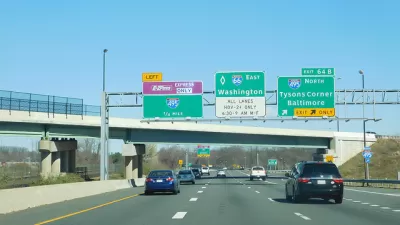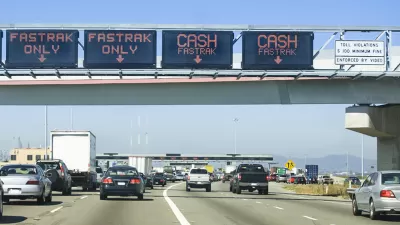Traffic speeds during the peak eastbound commute on the 66 Express Lanes Inside the Beltway have dropped to 35 mph. "Toll-tweaking" and changing the algorithm are achieving limited success on this dynamically-tolled stretch.

During commute hours, nine miles [png] of Interstate 66 in Northern Virginia, formerly known as the 66 Express Lanes Inside the Beltway, may operate like no other public roadway, let alone interstate, in the United States. During the morning restricted travel period from 5:30 a.m to 9:30 a.m., all (two to three) eastbound lanes are dynamically priced—there are no adjacent general purpose lanes for single-occupant vehicles (SOVs) to take to avoid paying a toll, which, on occasion, top $40.
The afternoon restricted travel period extends from 3 p.m. to 7 p.m. on all the westbound lanes. Once again, no "free lane" to choose if you lack a passenger.
The uncapped, dynamic tolling makes the roadway stand out as an example of how effective congestion or value pricing is at reducing congestion, encouraging modal alternatives, and funding public transit with toll revenues.
The operator of these time-restricted, high-occupancy toll (HOT) lanes, the Virginia Department of Transportation, is trying, perhaps paradoxically, to reduce the tolls and, at the same time, increase the speed, during the most congested part of the commute hour, from 8:15 a.m to 8:30 a.m, "when average speeds in April slowed below 35 mph," reports Max Smith for WTOP News on June 8. The roadway is unique for another reason: the low number of commute-hour SOVs.
About two-thirds of the vehicles on the road at that time are riding free — motorcycles, buses, and cars carrying at least two people with an E-ZPass Flex switched to HOV mode. Speeds in the morning remained slower than the same period a year earlier between 7:30 a.m. and 9:15 a.m.
While one way to deal with the slowdowns around 8:30 a.m. could be to raise tolls even higher as speeds significantly slow at that time, Virginia Transportation Secretary Shannon Valentine hopes changes to the tolling algorithm, along with better communication to commuters, could provide a different path if drivers change how they commute to either carpool, take the bus or go in at a different time.
It is somewhat ironic that an interstate highway that takes workers to the seat of American government would be one of the best examples in the country of applying market forces to auto travel.
“Because this is a true dynamic tolling system where people are making decisions in the moment based on the cost, it is true capitalism. … If we mandate certain limits, we can’t adjust it,” Valentine said.
Hat tip to AASHTO Daily Transportation Update.
FULL STORY: I-66 toll fix could urge you to wake up earlier

Manufactured Crisis: Losing the Nation’s Largest Source of Unsubsidized Affordable Housing
Manufactured housing communities have long been an affordable housing option for millions of people living in the U.S., but that affordability is disappearing rapidly. How did we get here?

Americans May Be Stuck — But Why?
Americans are moving a lot less than they once did, and that is a problem. While Yoni Applebaum, in his highly-publicized article Stuck, gets the reasons badly wrong, it's still important to ask: why are we moving so much less than before?

Using Old Oil and Gas Wells for Green Energy Storage
Penn State researchers have found that repurposing abandoned oil and gas wells for geothermal-assisted compressed-air energy storage can boost efficiency, reduce environmental risks, and support clean energy and job transitions.

Greening Oakland’s School Grounds
With help from community partners like the Trust for Public Land, Oakland Unified School District is turning barren, asphalt-covered schoolyards into vibrant, green spaces that support outdoor learning, play, and student well-being.

California Governor Suspends CEQA Reviews for Utilities in Fire Areas
Utility restoration efforts in areas affected by the January wildfires in Los Angeles will be exempt from environmental regulations to speed up the rebuilding of essential infrastructure.

Native American Communities Prepare to Lead on Environmental Stewardship
In the face of federal threats to public lands and conservation efforts, indigenous groups continue to model nature-centered conservation efforts.
Urban Design for Planners 1: Software Tools
This six-course series explores essential urban design concepts using open source software and equips planners with the tools they need to participate fully in the urban design process.
Planning for Universal Design
Learn the tools for implementing Universal Design in planning regulations.
Heyer Gruel & Associates PA
City of Moreno Valley
Institute for Housing and Urban Development Studies (IHS)
City of Grandview
Harvard GSD Executive Education
Salt Lake City
NYU Wagner Graduate School of Public Service
City of Cambridge, Maryland




























